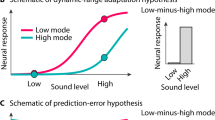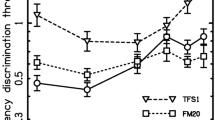Abstract
In natural environments, many sounds are amplitude-modulated. Amplitude modulation is thought to be a signal that aids auditory object formation. A previous study of the detection of signals in noise found that when tones or noise were amplitude-modulated, the noise was a less effective masker, and detection thresholds for tones in noise were lowered. These results suggest that the detection of modulated signals in modulated noise would be enhanced. This paper describes the results of experiments investigating how detection is modified when both signal and noise were amplitude-modulated. Two monkeys (Macaca mulatta) were trained to detect amplitude-modulated tones in continuous, amplitude-modulated broadband noise. When the phase difference of otherwise similarly amplitude-modulated tones and noise were varied, detection thresholds were highest when the modulations were in phase and lowest when the modulations were anti-phase. When the depth of the modulation of tones or noise was varied, detection thresholds decreased if the modulations were anti-phase. When the modulations were in phase, increasing the depth of tone modulation caused an increase in tone detection thresholds, but increasing depth of noise modulations did not affect tone detection thresholds. Changing the modulation frequency of tone or noise caused changes in threshold that saturated at modulation frequencies higher than 20 Hz; thresholds decreased when the tone and noise modulations were in phase and decreased when they were anti-phase. The relationship between reaction times and tone level were not modified by manipulations to the nature of temporal variations in the signal or noise. The changes in behavioral threshold were consistent with a model where the brain subtracted noise from signal. These results suggest that the parameters of the modulation of signals and maskers heavily influence detection in very predictable ways. These results are consistent with some results in humans and avians and form the baseline for neurophysiological studies of mechanisms of detection in noise.








Similar content being viewed by others
References
Baccus SA, Olveczky BP, Manu M, Meister M (2008) A retinal circuit that computes object motion. J Neurosci 28:6807–6817
Bacon SP, Opie JM, Montoya DY (1998) The effects of hearing loss and noise masking on the masking release for speech in temporally complex backgrounds. J Speech Lang Hear Res 41:549–563
Bee MA, Micheyl C (2008) The cocktail party problem: what is it? How can it be solved? And why should animal behaviorists study it? J Comp Psychol 122:235–251
Bee MA, Buschermohle M, Klump GM (2007) Detecting modulated signals in modulated noise: (II) neural thresholds in the songbird forebrain. Eur J Neurosci 26:1979–1994
Borrill SJ, Moore BC (2002) Evidence that comodulation detection differences depend on within-channel mechanisms. J Acoust Soc Am 111:309–319
Bregman AS (1994) Auditory scene analysis: the perceptual organization of sound. MIT Press, Cambridge
Cohen MF, Schubert ED (1987) The effect of cross-spectrum correlation on the detectability of a noise band. J Acoust Soc Am 81:721–723
Davis KA, Ramachandran R, May BJ (2003) Auditory processing of spectral cues for sound localization in the inferior colliculus. J Assoc Res Otolaryngol 4:148–163
Durlach NI (1963) Equalization and cancellation theory of binaural masking level differences. J Acoust Soc Am 35:1206–1218
Dylla M, Hrnicek A, Rice C, Ramachandran R (2013) Detection of tones and their modification by noise in nonhuman primates. J Assoc Res Otolaryngol 14:547–560
Efron B, Tishirani RJ (1993) An introduction to the bootstrap. Chapman & Hall/CRC, Boca Raton
Fantini DA (1991) The processing of envelope information in comodulation masking release (CMR) and envelope discrimination. J Acoust Soc Am 90:1876–1888
Fantini DA, Moore BC (1994) Profile analysis and comodulation detection differences using narrow bands of noise and their relation to comodulation masking release. J Acoust Soc Am 95:2180–2191
Fishman YI, Steinschneider M (2010) Neural correlates of auditory scene analysis based on inharmonicity in monkey primary auditory cortex. J Neurosci 30:12480–12494
Fishman YI, Volkov IO, Noh MD, Garell PC, Bakken H, Arezzo JC, Howard MA, Steinschneider M (2001) Consonance and dissonance of musical chords: neural correlates in auditory cortex of monkeys and humans. J Neurophysiol 86:2761–2788
Fishman YI, Micheyl C, Steinschneider M (2012) Neural mechanisms of rhythmic masking release in monkey primary auditory cortex: implications for models of auditory scene analysis. J Neurophysiol 107:2366–2382
Gans C (1992) An overview of the evolutionary biology of hearing. In: Webster DB, Fay RR, Popper AN (eds) The evolutionary biology of hearing. Springer, New York, pp 3–13
Gockel H, Carlyon RP, Micheyl C (1999) Context dependence of fundamental-frequency discrimination: lateralized temporal fringes. J Acoust Soc Am 106:3553–3563
Green DM, Swets JA (1966) Signal detection theory and psychophysics. Krieger, Huntingdon
Green DM, McKey MJ, Licklider JCR (1959) Detection of a pulsed sinusoid in noise as a function of frequency. J Acoust Soc Am 31:1446–1452
Grose JH, Hall JW 3rd (1989) Comodulation masking release using SAM tonal complex maskers: effects of modulation depth and signal position. J Acoust Soc Am 85:1276–1284
Gustafsson HA, Arlinger SD (1994) Masking of speech by amplitude-modulated noise. J Acoust Soc Am 95:518–529
Gutschalk A, Micheyl C, Melcher JR, Rupp A, Scherg M, Oxenham AJ (2005) Neuromagnetic correlates of streaming in human auditory cortex. J Neurosci 25:5382–5388
Hall JW (1986) The effect of across-frequency differences in masking level on spectro-temporal pattern analysis. J Acoust Soc Am 79:781–787
Hall JW, Haggard MP, Fernandes MA (1984) Detection in noise by spectro-temporal pattern analysis. J Acoust Soc Am 76:50–56
Hall JW 3rd, Grose JH, Haggard MP (1988) Comodulation masking release for multicomponent signals. J Acoust Soc Am 83:677–686
Hawkins JEJ, Stevens SS (1950) The masking of pure tones and of speech by white noise. J Acoust Soc Am 22:6–13
Jensen KK (2007) Comodulation detection differences in the hooded crow (Corvus corone cornix), with direct comparison to human subjects. J Acoust Soc Am 121:1783–1789
Johnson JS, Yin P, O’Connor KN, Sutter ML (2012) Ability of primary auditory cortical neurons to detect amplitude modulation with rate and temporal codes: neurometric analysis. J Neurophysiol 107:3325–3341
Joris PX, Smith PH, Yin TC (1994) Enhancement of neural synchronization in the anteroventral cochlear nucleus. II. Responses in the tuning curve tail. J Neurophysiol 71:1037–1051
Julesz B (1986) Texton gradients: the texton theory revisited. Biol Cyber 54:245–251
Kidd G Jr, Mason CR, Deliwala PS, Woods WS, Colburn HS (1994) Reducing informational masking by sound segregation. J Acoust Soc Am 95:3475–3480
Kidd G Jr, Mason CR, Dai H (1995) Discriminating coherence in spectro-temporal patterns. J Acoust Soc Am 97:3782–3790
Kidd G Jr, Mason CR, Arbogast TL (2002) Similarity, uncertainty, and masking in the identification of nonspeech auditory patterns. J Acoust Soc Am 111:1367–1376
Krishna BS, Semple MN (2000) Auditory temporal processing: responses to sinusoidally amplitude-modulated tones in the inferior colliculus. J Neurophysiol 84:255–273
Langemann U, Klump GM (2001) Signal detection in amplitude-modulated maskers. I. Behavioural auditory thresholds in a songbird. Eur J Neurosci 13:1025–1032
Langemann U, Klump GM (2007) Detecting modulated signals in modulated noise: (I) behavioural auditory thresholds in a songbird. Eur J Neurosci 26:1969–1978
Langner G, Schreiner CE (1988) Periodicity coding in the inferior colliculus of the cat. I. Neuronal mechanisms. J Neurophysiol 60:1799–1822
Macmillan NA, Creelman CD (2005) Detection theory: a user’s guide, 2nd edn. Lawrence Erlbaum Associates, Mahwah
Malone BJ, Scott BH, Semple MN (2007) Dynamic amplitude coding in the auditory cortex of awake rhesus macaques. J Neurophysiol 98:1451–1474
Malone BJ, Scott BH, Semple MN (2010) Temporal codes for amplitude contrast in auditory cortex. J Neurosci 30:767–784
McFadden D (1986) Comodulation masking release: effects of varying the level, duration, and time delay of the cue band. J Acoust Soc Am 80:1658–1667
McFadden D (1987) Comodulation detection differences using noise-band signals. J Acoust Soc Am 81:1519–1527
McFadden D, Wright BA (1990) Temporal decline of masking and comodulation detection differences. J Acoust Soc Am 88:711–724
Micheyl C, Carlyon RP (1998) Effects of temporal fringes on fundamental-frequency discrimination. J Acoust Soc Am 104:3006–3018
Micheyl C, Tian B, Carlyon RP, Rauschecker JP (2005) Perceptual organization of tone sequences in the auditory cortex of awake macaques. Neuron 48:139–148
Micheyl C, Carlyon RP, Gutschalk A, Melcher JR, Oxenham AJ, Rauschecker JP, Tian B, Courtenay Wilson E (2007) The role of auditory cortex in the formation of auditory streams. Hear Res 229:116–131
Moller AR (1976) Dynamic properties of the responses of single neurones in the cochlear nucleus of the rat. J Physiol 259:63–82
Moore BCJ (2003) An introduction to the psychology of hearing, 5th edn. Academic, San Diego
Moore BC, Borrill SJ (2002) Tests of a within-channel account of comodulation detection differences. J Acoust Soc Am 112:2099–2109
Muller-Preuss P, Flachskamm C, Bieser A (1994) Neural encoding of amplitude modulation within the auditory midbrain of squirrel monkeys. Hear Res 80:197–208
Nelken I, Bar-Yosef O (2008) Neurons and objects: the case of auditory cortex. Front Neurosci 2:107–113
Nelken I, Rotman Y, Bar Yosef O (1999) Responses of auditory-cortex neurons to structural features of natural sounds. Nature 397:154–157
Nelson PC, Carney LH (2007) Neural rate and timing cues for detection and discrimination of amplitude-modulated tones in the awake rabbit inferior colliculus. J Neurophysiol 97:522–539
Neuert V, Verhey JL, Winter IM (2004) Responses of dorsal cochlear nucleus neurons to signals in the presence of modulated maskers. J Neurosci 24:5789–5797
Niwa M, Johnson JS, O’Connor KN, Sutter ML (2012a) Activity related to perceptual judgment and action in primary auditory cortex. J Neurosci 32:3193–3210
Niwa M, Johnson JS, O’Connor KN, Sutter ML (2012b) Active engagement improves primary auditory cortical neurons’ ability to discriminate temporal modulation. J Neurosci 32:9323–9334
Nothdurft HC (1994) Common properties of visual segmentation. Ciba Found Symp 184:245–259, discussion 260–271
Olveczky BP, Baccus SA, Meister M (2003) Segregation of object and background motion in the retina. Nature 423:401–408
Pfingst BE, Hienz R, Miller J (1975) Reaction-time procedure for measurement of hearing. II. Threshold functions. J Acoust Soc Am 57:431–436
Pfingst BE, Laycock J, Flammino F, Lonsbury-Martin B, Martin G (1978) Pure tone thresholds for the rhesus monkey. Hear Res 1:43–47
Pressnitzer D, Meddis R, Delahaye R, Winter IM (2001) Physiological correlates of comodulation masking release in the mammalian ventral cochlear nucleus. J Neurosci 21:6377–6386
Ramachandran R, Lisberger SG (2005) Normal performance and expression of learning in the vestibulo-ocular reflex (VOR) at high frequencies. J Neurophysiol 93:2028–2038
Rees A, Moller AR (1983) Responses of neurons in the inferior colliculus of the rat to AM and FM tones. Hear Res 10:301–330
Rhode WS, Greenberg S (1994) Encoding of amplitude modulation in the cochlear nucleus of the cat. J Neurophysiol 71:1797–1825
Schooneveldt GP, Moore BC (1989) Comodulation masking release for various monaural and binaural combinations of the signal, on-frequency, and flanking bands. J Acoust Soc Am 85:262–272
Stebbins WC, Green S, Miller FL (1966) Auditory sensitivity of the monkey. Science (New York NY) 153:1646–1647
Velez A, Bee MA (2010) Signal recognition by frogs in the presence of temporally fluctuating chorus-shaped noise. Behav Ecol Sociobiol 64(10):1695–1709
Velez A, Bee MA (2011) Dip listening and the cocktail party problem in grey treefrogs: signal recognition in temporally fluctuating noise. Anim Behav 82(6):1319–1327
Wakefield GH, Edwards B (1987) Discrimination of envelope phase disparity. J Acoust Soc Am Suppl I 82:S41
Wakefield GH, Viemeister NF (1990) Discrimination of modulation depth of sinusoidal amplitude modulation (SAM) noise. J Acoust Soc Am 88:1367–1373
Wright BA (1990) Comodulation detection differences with multiple signal bands. J Acoust Soc Am 87:292–303
Yin P, Johnson JS, O’Connor KN, Sutter ML (2011) Coding of amplitude modulation in primary auditory cortex. J Neurophysiol 105:582–600
Yost WA, Sheft S (1989) Across-critical-band processing of amplitude-modulated tones. J Acoust Soc Am 85:848–857
Zar JH (1984) Biostatistical analysis. Prentice-Hall, Englewood Cliffs
Acknowledgments
This research was funded by a grant from the National Institutes of Health, R01 DC 11092. The authors would like to thank Mary Feurtado for the help during surgery, Bruce and Roger Williams for the hardware. Meagan Quinlan and Dr. Jason Grigsby collected some preliminary data and performed some preliminary data analysis.
Author information
Authors and Affiliations
Corresponding author
Rights and permissions
About this article
Cite this article
Bohlen, P., Dylla, M., Timms, C. et al. Detection of Modulated Tones in Modulated Noise by Non-human Primates. JARO 15, 801–821 (2014). https://doi.org/10.1007/s10162-014-0467-7
Received:
Accepted:
Published:
Issue Date:
DOI: https://doi.org/10.1007/s10162-014-0467-7




